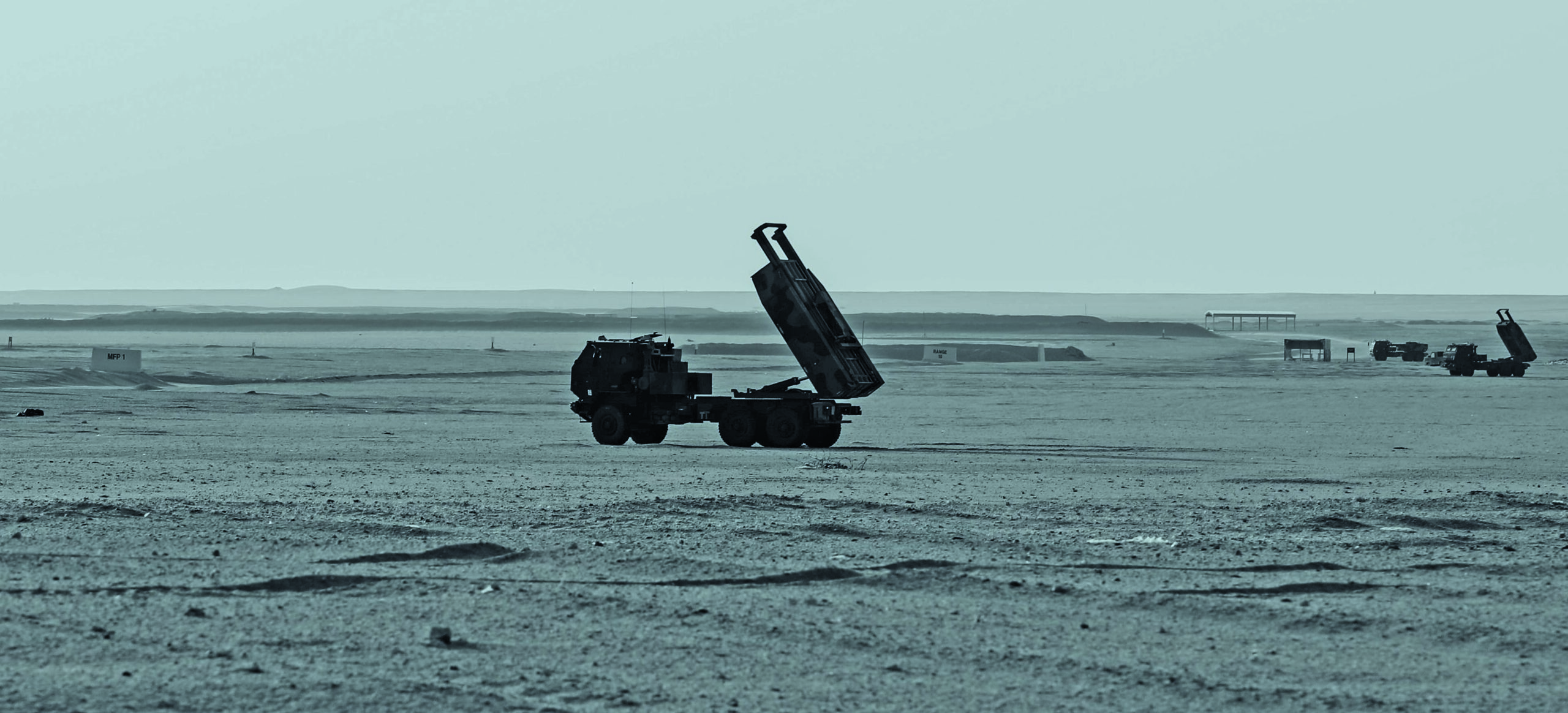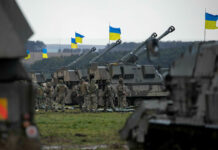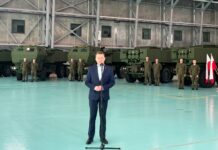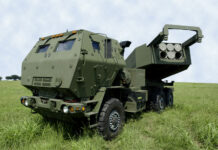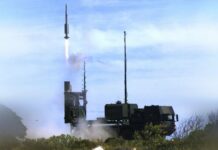Over the month of July, there have been a number of articles[1],[2] and social media posts[3] circulating online stating that S-400 has been failing to protect Russian armed forces arms caches and command posts from High Mobility Artillery Rocket System (HIMARS). This narrative is largely meaningless. While HIMARS does demonstrably pose a number of problems for Russia, the S-400 system has precious little to do with the success of HIMARS. The narrative[4] around S-400’s purported ‘failures’ has broadly arisen from a misunderstanding of both the ammunition natures Ukraine is using[5] with HIMARS as well as the S-400’s role and capabilities. To understand why this is the case, we must first take a closer look at both systems, and then examine the systems which could be used to defend against HIMARS, in the tactical and operational context of Ukraine.
Understanding S-400
The S-400 is a very large and complex air defence system which was, broadly speaking, developed as a successor to the S-200 series in role, and has much in common with the S-300P family, which it can be thought of as a heavily-upgraded version of. It is operated by Russia’s Aerospace Forces (VKS), and is primarily intended for protecting high-value points such as command posts, vital national infrastructure, and population centres from aerial and ballistic threats.
In Russian service, the S-400 system has five main missile models it can be armed with:
| Missile designation: | 48N6 | 48N6M/ 48N6P-01 | 48N6DM | 40N6 | 9M96M |
| Max. range: | 150 km (for aerial targets) | 200 km (for aerial targets) | 250 km (for aerial targets) | 400 km (for aerial targets) | 120 km (for aerial targets) |
| Max. altitude: | 27 km | 27 km | 30 km | 40 km | 30 km |
| Guidance: | Semi-Active Radar; Track-via-Missile | Semi-Active Radar; Track-via-Missile | Semi-Active Radar; Track-via-Missile | Active Radar | Active Radar |
| Max. quantity per transporter erector launcher (TEL): | 4 | 4 | 4 | 4 | 16 |
As the table shows, these missiles are mostly very long range weapons, with fairly decent maximum altitude characteristics. To provide an intuitive frame of reference for comparison, the typical cruising altitude of a civilian passenger jet is around 10.5-11.5 km, while the high-altitude U2 spy plane was capable of reaching an altitude of around 22 km. Most civilian and military aircraft fly well below this latter figure.
Given the S-400’s range of weapon options, its preferred target set with 48N6, 48N6M/48N6P-01, 48N6DM, and 40N6 consists of mostly large and high-value air-breathing targets, such as airborne early warning and control (AEW&C) aircraft, dedicated large electronic warfare (EW) aircraft, strategic bombers, and high-altitude reconnaissance aircraft. To a lesser extent, the target set also includes cruise missiles and short-range/theatre ballistic missiles. When equipped with 9M96M, the preferred target set changes slightly to favour aircraft and fighter aircraft, cruise missiles, and short-range ballistic missiles.
It is worth noting that although this range of munitions is theoretically available to Russia’s S-400s, the reality is a bit more complex. The newer and more capable 40N6 missile has not been observed very often in S-400 formations, with the older 48N6M/48N6P-01 and 48N6DM with semi-active seekers being much more commonly seen in Russia’s arsenal. Likewise, the smaller 9M96M missile has been shown being fitted to S-400 in training[6], but does not seem to have been widely distributed to S-400 formations. Instead, Russia seems to have mostly reserved this missile for its S-350 systems[7], which began to enter service[8] from February 2020 onward.
Yet even if Russia’s missile inventory contained plenty of the newer models with active radar seekers, none of the S-400’s possible missile loadouts are really intended for the counter-rocket, artillery and mortar (C-RAM) role. Firstly, the radar horizon will limit the ranges at which the system can detect and track targets, which means that at long ranges, the system’s radar may not detect the rockets, or if it can, they might not remain above the horizon sufficiently long to be engaged. Secondly, artillery rockets will have a fairly low frontal radar cross section (RCS), which will make the rockets more challenging for the system’s radars to detect and track at longer ranges. Finally, engaging numerous and low-cost artillery projectiles with large and expensive long-range missiles is not economically or industrially sustainable.
For these reasons, C-RAM systems typically operate at Very Short Range Air Defence (VHSORAD) or Short Range Air Defence (SHORAD) ranges, while medium- and long-range systems are usually reserved for dealing with high altitude air-breathing targets and ballistic missiles.
A closer look at HIMARS
Ukraine has evidently attained noteworthy success using the M142 HIMARS system in the Donbass. This has been made evident with numerous pieces of testimony[9],[10],[11],[12], as well as photos[13] and video footage[14] shared by both sides shared on social media. The picture formed from open sources is broadly that HIMARS has been quite effective, having been used to destroy a number of Russian Armed Forces ammunition caches, command posts, and other important objects.
HIMARS can be loaded with various ammunition types, and a single vehicle can be armed with either six 270 mm guided artillery rockets from the M30 GMLRS family, with a maximum range of approximately 84 km, or a single 610 mm Army Tactical Missile System (ATACMS) family quasi-ballistic missile with a maximum range of 300 km. Both the GMLRS and ATACMS family are available with various warhead types, including submunition, unitary pre-formed fragment, and unitary explosively-formed fragment variants[15]. As footage from the front[16] and official announcements[17] have both shown, Ukraine has only been provided with GMLRS series rockets so far. This is important because, of these two ammunition families, only the ATACMS could realistically be considered part of S-400’s target set.
The primary benefit of HIMARS for the Ukrainian military has been the system’s combination of accuracy and range. Ukraine previously operated Soviet-era rocket artillery including the 122 mm Grad, 220 mm Uragan and 300 mm Smerch systems[18], of which the latter Smerch system has a range of 90 km[19], similar to HIMARS with GMLRS’ range of 84 km[20]. However Ukraine’s Smerch systems (and indeed the majority of Russia’s, with the exception of the newer Tornado-S systems), use unguided rockets. These lose accuracy the further they go from their point of launch, resulting in a much larger circular error probable (CEP) when launched at more distant targets.
HIMARS armed with GMLRS rockets by contrast does not suffer from this loss of accuracy thanks to the rockets’ combined inertial/GPS guidance[21], and this has enabled the Ukrainian Armed Forces to conduct both long-range and accurate strikes. The systems’ value is further enhanced by US intelligence provided to Ukraine, which has been reported by the New York Times to include targeting data[22].
The result is that Ukraine has been able to strike high-value Russian targets at safer distances, outside the range of most Russian artillery platforms. This limits the Russian response to either throwing air power at the problem and risking attrition of aerial platforms, expenditure of precious cruise or short-range ballistic missiles, or relying on longer-range systems such as Smerch batteries for counterfire, where they will be operating at a relative accuracy disadvantage. None of these are ideal solutions to the problem.
Being able to strike from safer distances also generates secondary problems for Russia. For starters, it greatly complicates the task of Russian reconnaissance teams when it comes to locating the launch sites, since the area which needs to be searched becomes much larger when compared to shorter-range artillery. Secondly, it pressures Russia to position its munitions stockpiles further back from the front lines, which increases resupply distances[23] and complicates logistics, making it more difficult for Russia to conduct high-intensity operations, and so slowing down the pace of the advance.
The HIMARS has undoubtedly shown itself to be a valuable asset for Ukraine, however this has nothing to do with S-400. In large part this is because Ukraine has only been provided with GMLRS series rockets. The S-400 was never intended to serve as a C-RAM system, and consequently it is illogical to claim the system is failing at a task it is not performing and was not intended to perform. Since S-400 is not a solution to GMLRS strikes, it is time to examine what C-RAM solutions the Russian Armed Forces have, and what factors impact their effectiveness in Ukraine.
Setting expectations for C-RAM
Despite incurring losses during the first phase of the invasion, Russia still maintains a large and diverse fleet of air defence systems geared towards many different threat types, including artillery rockets. In the case of HIMARS, Russia’s Tor and Pantsir-S SHORAD system families would probably be the most likely candidates capable of reducing the effectiveness of GMLRS salvos. GMLRS missiles do not perform complex manoeuvres and it should be possible for Russia to intercept a percentage of them. Indeed, some images[24], and footage shared on social media suggest it may have already done so, though many of the claims are hard to verify. While it is certainly possible to conduct C-RAM successfully, there are a range of tactical and operational challenges which complicate this task.
For starters, it is worth tempering expectations about what even very good C-RAM systems can realistically achieve. The Israeli Iron Dome system for instance is often regarded as the posterchild successful C-RAM system. Yet a sizeable part of its success can be attributed to the system operating under conditions as close as possible to optimal for a C-RAM system – its targets are largely crude and inaccurate artillery rockets which are launched from highly predictable directions, typically 70-80 percent completely miss their targets[25] and are therefore ignored by the system and not intercepted. Additionally, the electromagnetic spectrum in their area of operation is not contested by hostile jamming, minimal airspace deconfliction is needed, and Israeli air power has total freedom to hunt down and strike launch sites within minutes of launches being detected. Iron Dome’s interception record is pretty good, estimated at between 75-90 percent depending on the conflict[26], yet even under these near-optimal conditions, hostile rockets still can and do get through the defences, often causing damage to civilian infrastructure[27],[28].
In modern peer- and near-peer conflict conditions, rocket artillery tends to be far more accurate than that of non-state armed groups, meaning the defender has a relatively greater quantity of threats to target, and strikes can come from less-predictable directions. On top of this, the rockets typically fly faster and their warheads are typically more lethal compared to crude designs used by militant groups. This combination of factors means that even a single rocket can cause catastrophic damage if it is accurate enough to hit an ammunition stockpile or important command post. As such, even under optimal conditions it would be unrealistic to expect any C-RAM system to be 100 percent effective in dealing with a high-volume threat such as a GMLRS barrage. C-RAM in peer- and near-peer conflicts is very difficult, and expectations of success should be adjusted accordingly.
The difficulties of C-RAM on the Ukrainian front
With this context in mind, we can turn our attention to Tor and Pantsir-S SHORAD systems. On paper, both of these systems have the capability to engage GMLRS rockets, however the real-world performance of both systems would appear to be unequal. While Pantsir-S has been criticised perhaps a bit too harshly in popular media, which ignored important context behind many of its losses in Syria and Libya, some criticism seems justified, not least that provided in Russian sources.
The closest basis for a head-to-head comparison of Tor and Pantsir was the performance of both of these systems while defending Khmeymim Airbase in Syria during in the period from April-October 2018. In Syria their targets consisted mostly of small UAVs, but were understood to have also included some types of threat such as mortar rounds. According to Viktor Murakhovsky, editor of the Arsenal Otechestva magazine, during this period the deployed Tor-M2U (also known as Tor-M1-2U) systems managed to intercept 80 hostile targets, with a rate of 80 percent successful interceptions, compared to the Panstir-S sytems’ rate of 19 percent successful interceptions during the same period[29]. This figure should be treated with a little bit of caution, since it has not been officially confirmed, but it aligns with other anecdotal comparisons between the two systems in Russian sources[30],[31]. Broadly speaking then, the Tor family seems to have enjoyed more operational success than the Pantsir family, and would be expected to be more reliable in the C-RAM role.
According to The Military Balance 2022, Russia possessed over 136 Tor family Transporter-Launcher and Radar (TLAR) vehicles (equating to 34 batteries), and 80 Pantsir-S self-propelled anti-aircraft gun and missile (SPAAGM) vehicles (20 batteries) prior to the outbreak of the war[32], and according to open sources has lost approximately 16 Tor TLARs and 8 Pantsir SPAAGM vehicles[33], leaving around 29 batteries of Tor and 18 batteries of Pantsir-S remaining. Even if we make the unrealistic assumption that Russia would deploy its entire remaining fleet of these vehicles, they would be required to defend a front over 1,100 km long[34] in the most active portion of the warzone – the Donbass and the South. The land area occupied by Russia is approximately 126,610 km2, which is equivalent to ~35 percent of Germany, or ~50 percent of the UK[35]. Of this total, roughly 92,400 km2, or 72 percent of this area would be within GMLRS range. While not all this land is used by the Russian military, it nonetheless contains a large number of points to defend, often with long distances between them.
While it would be theoretically possible to cover the length of just the front line using all of Russia’s remaining Tor and Pantsir-S systems, such broad coverage would spread these assets very thinly, resulting in an overall low density of cover, and would ultimately not help with regard to C-RAM where ideally the defensive system should be positioned relatively close to the target it is intended to protect, and in sufficient numbers to resist saturation attacks. For reference, a battery of four HIMARS could output 24 GMLRS missiles in a matter of seconds, which could easily overwhelm insufficiently dense C-RAM. Assuming a probability of kill (pK) of 0.7, this salvo would require at least 35 missiles to intercept, which is more than the total ready missiles carried by a battery of the older Tor family variants (including Tor, Tor-M1, Tor-M2U). It therefore makes the most sense to concentrate these systems where they are needed most, but doing so will inevitably leave gaps in other places which could be taken advantage of. Given the US’s formidable intelligence-gathering capabilities, it is highly likely that they would be able to identify Russian points with weaker defences, assisting Ukraine’s target selection and increasing the odds of GMLRS strikes successfully destroying their targets. Indeed, it would be surprising if this were not already happening.
Alongside gaps in coverage, there will also be gaps in availability caused by human and mechanical factors – crews need sleep, radars cannot be left switched on permanently, and sometimes the vehicle may need to be switched off to conserve fuel. These gaps in availability generate further opportunities for artillery strikes to pass through the defences.
A challenging task ahead
In summary then, conducting effective C-RAM in peer- near-peer warfare is extremely difficult. Russia should not be expected to be capable of completely resolving the problem of GLMRS strikes, but there are practical steps it can and likely will take toward decreasing its vulnerability to them. These will probably include positioning some supply caches and command posts further back to decrease the number which need to be heavily defended, while ensuring the caches which have to be within HIMARS range are less densely-packed to reduce the risk of sympathetic detonation destroying an entire stockpile, and increasing C-RAM density around these critical points.
The Russian advance may have been slowed to a crawl in recent weeks, but they have not lost the capacity to adapt to their circumstances. The rapid success of HIMARS is in some part down to the fact that it is new to the theatre[36], and the Russian Armed Forces have so far not had sufficient experience in organising themselves in response to this capability. Once the relevant operational and tactical solutions are implemented, it is probable that HIMARS strikes will begin to decrease in effectiveness, though they are unlikely to ever be nullified completely. The key question therefore becomes whether HIMARS systems will manage to inflict sufficient damage to meaningfully alter the battlefield during this window of effectiveness.
Mark Cazalet
[1] https://sundries.com.ua/en/the-advertised-russian-s-400-systems-proved-powerless-against-himars/
[2]https://m.censor.net/en/news/3353128/scandal_in_russian_concern_azmazantey_according_to_documents_s400_complexes_should_shoot_down_himars
[3] https://twitter.com/Gerashchenko_en/status/1546526587188830208
[4] https://twitter.com/jtreble_me/status/1546903503326658560
[5] https://twitter.com/NutjobCollectio/status/1547111814814904323
[6] https://topwar.ru/176208-v-seti-pojavilos-video-puska-zur-9m96-s-shassi-mzkt-7930-zrs-s-400.html
[7] http://bastion-karpenko.ru/s-350_vityz/
[8] http://eng.mil.ru/en/news_page/country/more.htm?id=12279447@egNews
[9]https://www.facebook.com/GeneralStaff.ua/posts/pfbid0LqBbYFX2J5SNk9o2wvR7jVa3eeyYTtvdaqa5erHLXhHrjt7jEpq9JzA9aHNtuJJRl
[10] https://twitter.com/RALee85/status/1549141309880995846
[11] https://twitter.com/RALee85/status/1547744209171402753
[12] https://twitter.com/DefenceU/status/1547992158514188290
[13] https://twitter.com/Yesthisisdog1/status/1546603834772004869
[14] https://twitter.com/visegrad24/status/1549070271654535168
[15] https://ndiastorage.blob.core.usgovcloudapi.net/ndia/2016/armament/Turner.pdf
[16] https://twitter.com/Archer83Able/status/1549401238353108993
[17] https://www.defense.gov/News/Releases/Release/Article/3064556/joint-statement-by-the-united-states-department-of-defense-the-ministry-of-defe/
[18] The Military Balance (2022), p212
[19] https://topwar.ru/195741-rszo-smerch-bezzhalostnoe-sovershenstvo.html
[20] https://ndiastorage.blob.core.usgovcloudapi.net/ndia/2016/armament/Turner.pdf
[21] https://ndiastorage.blob.core.usgovcloudapi.net/ndia/2016/armament/Turner.pdf
[22] https://www.nytimes.com/2022/05/04/us/politics/russia-generals-killed-ukraine.html
[23] https://twitter.com/DefMon3/status/1548684752135364608
[24] https://twitter.com/Archer83Able/status/1549401238353108993
[25] https://youtu.be/6pYIUN5sq5o?t=1779
[26] Janes Artillery and Air Defence (2022-2023), p586
[27] https://www.alamy.com/the-damage-in-a-residential-building-hit-by-a-rocket-fired-from-the-gaza-strip-on-may-15-2021-in-ramat-gan-israel-heavy-exchange-of-fire-between-palestinian-militants-and-the-israeli-military-continues-militants-have-fired-more-than-1800-rockets-towards-israel-since-monday-night-while-israel-has-hit-over-750-targets-in-gaza-in-response-image426209731.html
[28] https://www.alamy.com/the-damage-in-a-residential-building-hit-by-a-rocket-fired-from-the-gaza-strip-on-may-13-2021-in-petah-tikva-israel-heavy-exchange-of-fire-between-palestinian-militants-and-the-israeli-military-continues-militants-have-fired-more-than-1500-rockets-towards-israel-since-monday-night-while-israel-has-hit-hundreds-of-targets-in-gaza-in-response-image426052091.html
[29] https://vz.ru/news/2018/11/2/949009.html
[30] http://www.vif2ne.org/nvk/forum/0/archive/1703/1703213.htm
[31] https://www.vesvks.ru/vks/article/ischezayuschie-perspektivy-nastoyaschee-i-bespokoy-16360
[32] The Military Balance (2022), p
[33] https://www.oryxspioenkop.com/2022/02/attack-on-europe-documenting-equipment.html
[34] https://liveuamap.com/en (as of 21/07/2022)
[35] https://www.newstatesman.com/world/europe/ukraine/2022/07/how-occupied-ukraine-territory-interactive-map-war-russia (as of 12/07/2022)
[36] https://twitter.com/KofmanMichael/status/1541806151112835072


